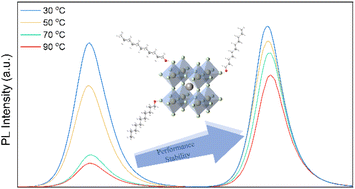Stability and spectroscopic analysis of CsPbBr3 quantum dots modified with 2-n-octyl-1-dodecanol
Abstract
Due to their excellent optical and electrical properties, all-inorganic metal halide perovskite CsPbBr3 quantum dots (QDs) have become one of the most promising materials in the field of optoelectronics during recent years. However, the stability of CsPbBr3 QDs limits their practical application and further development to a certain extent. In order to improve their stability, CsPbBr3 QDs were modified with 2-n-octyl-1-dodecanol for the first time in this paper. The 2-n-octyl-1-dodecanol-modified CsPbBr3 QDs were prepared by the ligand-assisted reprecipitation (LARP) method at room temperature in an air environment. Then the stability of the samples was tested at different temperatures and humidity. When the humidity was 80%, the photoluminescence (PL) intensity of both unmodified and modified CsPbBr3 QDs increased to different degrees because the appropriate amount of water changed the crystallization environment. The PL intensity of the modified QDs increased, and the peak positions were basically not shifted, proving that they did not agglomerate. Thermal stability test results showed that the PL intensity of the 2-n-octyl-1-dodecanol-modified QDs could still maintain 65% of the original intensity at 90 °C, which is 4.6 times that of the unmodified CsPbBr3 QDs. Experimental results show that the stability of CsPbBr3 QDs is significantly improved after 2-n-octyl-1-dodecanol modification, which demonstrates the excellent surface passivation of CsPbBr3 QDs by 2-n-octyl-1-dodecanol.

- This article is part of the themed collection: Analytical Methods HOT Articles 2023


 Please wait while we load your content...
Please wait while we load your content...